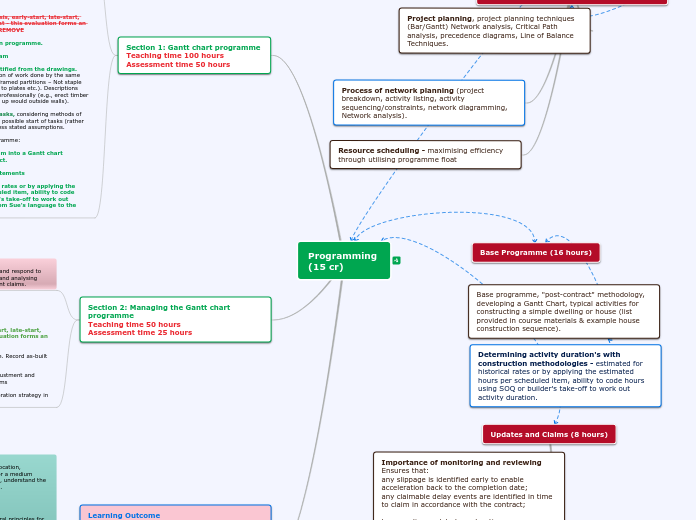Programming
(15 cr)
Section 1: Gantt chart programme
Teaching time 100 hours
Assessment time 50 hours
Learning Outcomes
1. Develop a construction programme applying networking principles to produce a critical path Gantt chart and network diagram.
GPOs
GO 3 Manage construction and resource allocation, programming and construction activtities, for a medium building and for medium and large buildings, understand the principles related to the provison of services.
LO1: 5 cr
GO 5 Apply broad knowledge of the structural principles for building work including foundations, substructure, the envelope and the interior, and passive fire protection systems for medium and large buildings.
LO1: 2 cr
GO8 Develop construction plans and methodologies, for medium buildings.
LO1: 1 cr CM ONLY
Critical path network analysis, early-start, late-start, early-finish, late-finish, float - this evaluation forms an introduction to the course REMOVE
Develop a base construction programme.
1. Prepare a network diagram
1.1 First, list the tasks identified from the drawings. Typically, a task will be a portion of work done by the same contractor (e.g., erect timber framed partitions – Not staple DPC to bottom plate, nail stud to plates etc.). Descriptions should be written clearly and professionally (e.g., erect timber framed external walls. Not put up would outside walls).
1.2 Second, sequence the tasks, considering methods of construction. Focus on earliest possible start of tasks (rather than resource availability) unless stated assumptions.
2. Develop a Gantt chart programme:
2.1 Convert network diagram into a Gantt chart programme using MS Project.
3. Prepare task method statements
3.1 Estimated for historical rates or by applying the estimated hours per scheduled item, ability to code hours using SOQ or builder's take-off to work out activity duration. (taken from Sue's language to the right)
Section 2: Managing the Gantt chart programme
Teaching time 50 hours
Assessment time 25 hours
Learning Outcomes
3. Manage a programme against progress and respond to contingent events, re-scheduling resources and analysing claim entitlement to produce time adjustment claims.
GPOs
GO 3 Manage construction and resource allocation, programming and construction activtities, for a medium building and for medium and large buildings, understand the principles related to the provison of services.
LO3: 2 cr
GO6 Analyse, select and adminster construction contracts including the preparation of a tender submission from trade sections and other financial components and value building works up to and including final account statements.
LO3: 1 cr
Critical path network analysis, early-start, late-start, early-finish, late-finish, float - this evaluation forms an introduction to the course
Recording progress against base programme. Record as-built and as-planned programmes
Evaluate contractual entitlement to time adjustment and prolongation costs and prepare contract claims
Establish an updated programme and acceleration strategy in response to delay events
Learning Outcome
1. Develop a construction programme applying networking principles to produce a critical path Gantt chart and network diagram.
2. Formulate a post-contract construction method statement.
3. Manage a programme against progress and respond to contingent events, re-scheduling resources and analysing claim entitlement to produce time adjustment claims.
GPOs
GO 3 Manage construction and resource allocation, programming and construction activtities, for a medium building and for medium and large buildings, understand the principles related to the provison of services.
LO1: 5 cr
LO2: 3 cr
LO3: 2 cr
GO 5 Apply broad knowledge of the structural principles for building work including foundations, substructure, the envelope and the interior, and passive fire protection systems for medium and large buildings.
LO1: 2 cr
LO2: 1 cr
GO6 Analyse, select and adminster construction contracts including the preparation of a tender submission from trade sections and other financial components and value building works up to and including final account statements.
LO3: 1 cr
GO8 Develop construction plans and methodologies, for medium buildings.
LO1: 1 cr CM ONLY
LO2: 1 cr CM ONLY
GO9 Assemble quantity surveying documentation relevant to specialist and specific trade sections and measure a schedule of quantities for a small building of an individual trade section including services.
LO2: 1 cr QS ONLY
